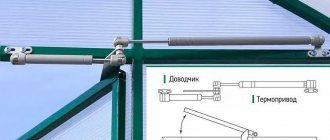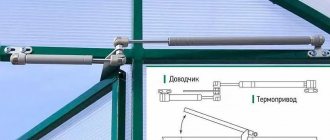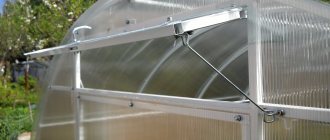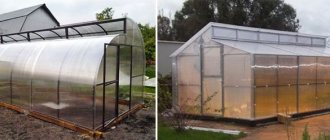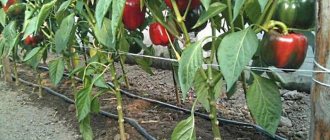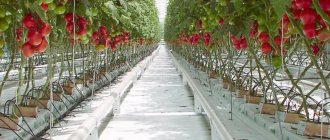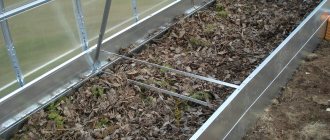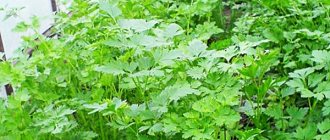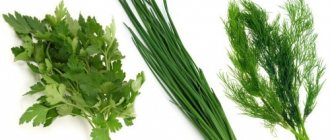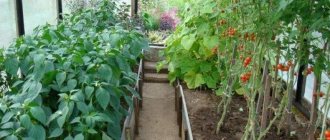How to place the necessary equipment and devices for caring for plants in the greenhouse to ensure maximum comfort for work? Every gardener asks himself this question sooner or later. Winter is the time to inspect existing tools, repair them, sharpen them, and place them so that everything is at hand. Every gardener spends a lot of time in a greenhouse, and therefore optimal equipment for the workplace will save a lot of time and effort. First, we will determine the list of what needs to be prepared for the summer season.
Capital greenhouses, equipped with ventilation, heating, irrigation and lighting systems, are intended, if not for year-round cultivation of vegetables, then at least for extending the gardening season. They should protect plants from low temperatures in the spring and protect them from autumn frosts in the fall. And working in it should be comfortable and convenient.
When arranging a greenhouse, you should take care of the arrangement of beds and passages between them. The width of the ridge should be such that you can easily reach the plants growing on it. Carrying out all technological operations, planting, weeding, loosening, must be handy.
The beds are made raised, for this they are fenced with boards and slate so that the soil does not spill onto the paths. This topic is broad and requires a separate article.
Arrangement of seedlings
We take the seedlings and arrange them so that all the plants get the light and the leaves of the seedlings do not intertwine or even touch. This is necessary to provide light and warmth. This will be the best care.
The plant is growing and needs to be planted in time in the main soil - greenhouse soil from the container, because the stems can stretch out enough and even 2-3 fruits will form on one cluster, and the plant itself will spend entirely on the formation of these particular fruits. We constantly remove small stepsons. The upper stepson can be left; it forms a second stem located next to the flower stem.
When transporting to the dacha, so that the plants do not break and feel comfortable, try not to water the seedlings a few days before transportation; it is better to dry them, the stems will not be brittle and the plant will better tolerate a stressful situation.
From the middle or end of May, you can safely begin planting tomato seedlings in a film greenhouse or greenhouse. If you have a warm greenhouse, heated, and if you have a warm heated bed, using biofuel, based on plant residues, then you can start planting tomatoes in early May. It all depends on the specific greenhouse and weather conditions.
A prerequisite for good production and good fruiting is that soil and bed preparation must be carried out immediately before planting tomato seedlings. We dig up the ridge, loosen it, level it with a rake, then you need to add mineral fertilizers so that fruiting is abundant and good.
More air
If you are concerned about arranging a greenhouse with the latest technology, do not forget about the ventilation system. Why is it needed, because you can get by with windows? You cannot create full air exchange with simple vents. Especially if the greenhouse is large.
Special fan for greenhouse
You will need:
Ventilation in the greenhouse
And it is advisable to combine all this into a forced ventilation system that will work without your intervention. You don’t have to open/close the windows and control the cleanliness and freshness of the air - the automated process will do everything for you.
An alternative option is to ventilate greenhouses with roll-up film curtains
Drip irrigation "Beetle"
This system of root drip irrigation got its name for a reason - the fact is that the arrangement of the droppers is reminiscent of the arrangement of the legs of a living beetle. Many small ones diverge from the main (main) pipes. Read more here.
Why do you need a ventilation machine?
Perhaps this simple and inexpensive unit will become your best assistant. A special mechanism designed to automatically open and close vents to maintain temperature and ensure fresh air circulation.
Automatic ventilation in the greenhouse with a thermal drive system
The device operates without batteries - the operating principle is based on the expansion and contraction of a liquid placed in a black cylinder, which occurs under the influence of the heat of the sun's rays. Heating expands the liquid, pushing the piston out, opening the window. Cooling compresses and hides the piston back, closing the source of cold and draft.
Reinforced automatic ventilator Vent L 01 and 02
For polycarbonate greenhouses, this is an excellent and inexpensive ventilation option. The service life of this simple device is 10 years. It is placed on the side (not gable) windows, and for the winter it is removed and put away.
Video - Thermal actuator for a greenhouse
Something about thermostats
Automatic regulation of greenhouse temperature is very convenient, especially during a long absence of the owner and sudden temperature changes outside the greenhouse. To carry out this process, you need a thermostat (thermostat).
Greenhouse thermoregulation diagram
Table. Types and properties of thermostats.
| View | Description |
| Electronic | A high-precision option with a liquid crystal display, the use of which makes it possible to always see reliable information about the temperature in the greenhouse and respond to changes in a timely manner. |
| Sensory | Not as good as an electronic one, but you can set a program in it that will provide the opportunity to create the temperature required at a certain time of day. |
| Mechanical | The installation is as simple as possible, but still allows for sufficient control of soil temperature. For a mechanical thermostat, the temperature is set once and then adjusted depending on the needs of the plant. For small private greenhouses, this option is the most acceptable. |
How to choose a thermostat
Thermostats are devices that are easy to use. There is a menu scroll button. Manual temperature adjustment. Function of recording quick launch settings into memory. Monitoring the operation of the heating system and the ability to set heating parameters. In models with a display, you can monitor the current temperature status.
Step 1. First choose the appearance. It can be different, and it’s not only about aesthetics, but also about size, as well as ease of use.
Step 2. Then we study the power. This parameter needs to be given special attention. It is always better to take a device with more power than is required to heat your area of soil.
Thermoregulator TP 600 for soil heating systems in greenhouses
Step 3. Select the installation method. Installation can be different - mounted or hidden, which is not easy to do yourself. Please pay attention to this when purchasing.
Step 4. Select a control system. The operation of the device is controlled by a sensor, which can be either external or hidden. Pay attention to what is more convenient for you.
Step 5. Next comes installation and configuration.
- The adjustment block and the temperature control block - the two main components of the device - are made using transistors.
- Use the switch to set temperature options.
- Connect the relay to your heating device using the contacts.
- Set up your device. To do this, calibrate the resistor scale.
Schematic diagram of a greenhouse thermostat
Prices for a thermostat for greenhouses
thermostat for greenhouses
General information
Nowadays, people strive to eat environmentally friendly products. Most have their own dachas and grow their own vegetables and fruits. But they cannot do without certain equipment. Entrepreneurship in the sphere of providing such people with everything they need is gradually gaining momentum.
Country greenhouses are especially popular. They differ from each other in size, equipment and configuration. Various materials are used for their manufacture. According to their purpose, greenhouses are divided into personal, industrial and farm.
Tips for beginner gardeners
The greenhouse is equipped according to the following plan:
- Start by studying the conditions that the crops you grow need. This will help determine whether lighting and heating will be needed.
- Then decide on a watering system for the greenhouse.
- Plan the placement of the required equipment.
- Now determine the size of the beds and paths. They need to be equipped after the engineering systems for greenhouses have been installed: water supply system and others. But you need to calculate where they will be located in advance.
- Then you need to move on to placing additional inventory: racks, shelves and other elements.
Before considering purchasing expensive equipment, find out if there is a possibility to solve the problem in simpler ways. For example, for ventilation, you can simply open the window, or you can install a special mechanism that will automatically open it. Unfortunately, any additional equipment will affect the final cost of production. And this must be taken into account.
Arranging a greenhouse is no less important a stage than its construction. After all, the correct organization of space and microclimate has a significant impact on plant productivity.
Construction works
| Name | Qty | price, rub. | Amount, rub. |
| Greenhouse assembly | 1 PC. | 6500 | 6500 |
| Laying strip foundation | 18 m | — | 10800 |
| Laying a block foundation | 18 m | — | 5600 |
| Laying a timber foundation | 18 m | — | 2000 |
With a continuous flow of customers, four people (including the owner of the business) can manufacture and install up to 15 arched greenhouses within a month. Income in this case is determined not only by the size of the product itself, but also by the type of foundation.
Types of polycarbonate
In Russia, according to GOST, polycarbonate panels are categorized as “Safety glasses”. They have a high degree of transparency, which does not reduce their strength and durability. Sheet polycarbonate is available in two types - solid and cellular. The latter has a complex structure, which increases its ability to retain heat.
IMPORTANT ADDENDUM!
The thicker the polycarbonate sheet, the softer the light and the lower the light conductivity.
For greenhouses, cellular polycarbonate with a thickness of 4 to 8 millimeters is usually used. These types of polycarbonate have, on the one hand, high strength and lightness, on the other hand, they transmit light well and retain heat.
Cellular polycarbonate
Cellular polycarbonate in section
Types of cellular polycarbonate: diagram
In addition, cellular polycarbonate sheets are impregnated with a special protective layer that does not transmit ultraviolet rays. Solid polycarbonate, also called monolithic, is used for making shop windows, canopies and partitions in public places. Externally, it is indistinguishable from ordinary glass.
Solid polycarbonate
But, unlike its fragile predecessor, it is several times lighter and 250 times stronger. In this indicator, it even surpasses plexiglass.
INTERESTING FACT!
Polycarbonate, along with gold, platinum and silver, was chosen as the material for the medals of the 2014 Winter Olympics in Sochi.
The game organizers felt that this material was better suited than others for two reasons. Firstly, this type of plastic does not change under the influence of both low and high temperatures. And secondly, you can easily apply any design to it. So, for the first time in the world, the Russians came up with a medal with almost real “ice”.
Medal of the Olympic Games in Sochi
Durable and lightweight. Polycarbonate sheets are used to create display cases, partitions in banks, and canopies. Strong “glass” cannot be broken even with a hammer.
Equipment with protected glass made of monolithic polycarbonate
Canopy made of colored monolithic polycarbonate
What determines the choice of equipment for greenhouses?
The greenhouse makes it possible to grow plants from all over the world. But before you stock up on seeds, potted citrus, orchids or other plants, you need to stop and think about what kind of growing environment you need to provide for them.
You cannot fill the greenhouse with any plants you like. Some of them need a cool microclimate, while others like warmth. Some like bright sunlight for 6-8 hours, while others require filtered, dim lighting. In unsuitable conditions, plants will begin to hurt after a while. Therefore, the gardener’s task is to select plants that need the same conditions for development and provide these conditions.
A properly planned structure will provide plants with normal growth conditions, and the gardener will feel comfortable staying in it and caring for crops.
The temperature range for winter and summer must be determined during year-round operation of the greenhouse. Winter temperatures ranging from +4°C to +16°C will be ideal for growing salad greens and herbs. Vegetables will require higher temperatures (up to +22°C), which means installing a heating system. Summer temperatures of +29...+30°C in combination with bright sun are suitable for potted tomatoes or geraniums, but are unacceptable for violets and orchids. To ensure coolness, air cooling equipment is used.
Did you know? The first description of a heated greenhouse comes from Sanga York, a treatise on agriculture compiled by a royal physician of the Joseon Dynasty in Korea in the 1450s. The treatise contains detailed instructions for constructing a greenhouse for growing vegetables, flowers, and fruits using ondol, a traditional Korean underfloor heating system.
More light
Additional lighting is necessary if you grow seedlings in early spring or grow individual greenhouse plants in the fall. Most crops require at least 8 hours of daylight. Lamps help solve this problem with short daylight hours.
The main types of lamps used in them:
- Incandescent lamps - the oldest type, known to everyone since childhood. They are as cheap as possible, but have a number of disadvantages. Their spectrum does not coincide with the sun's due to the lack of the blue range of light. This means that plants become deformed under this lighting. They also use a lot of energy, heat up quickly, and can damage polycarbonate if attached too close to it.
- Fluorescent lamps appeared as an alternative to the previous type. They are widely used now and are a budget lighting option. Perfect for background lighting of plants. They are often used when growing flowers. But they cannot organize spot lighting of an area, for example, a rack with seedlings.
- Sodium lamps characterized by maximum light output and the same heat output. And this allows you to save on heating. They are as close as possible to the solar spectrum. But their main drawback is overheating. And this is quite dangerous for plants.
- Metal halide lamps They illuminate the room well, have high luminous efficiency and can last a very long time. But the cost of such lamps is quite high. In addition, they must be covered with a lamp, as they can explode.
- LED or LED lamps consume the least amount of energy and also allow you to adjust the light intensity. Due to the fact that this type of lamp appeared relatively recently, farmers do not have a common opinion on the advisability of using them. And they have both supporters and opponents. The advantages of LEDs are the absence of overheating. They are not affected by humidity or temperature changes. They are safe to touch. Most often, this type of lamp is used for illumination when growing seedlings.
More warmth
Heating is only necessary for those greenhouses that will be used in winter. These are usually large production facilities. It is not practical to heat a small greenhouse to satisfy personal needs.
Heating of the greenhouse can be electric or gas. Electric heating is easier to install, costs less and can be arranged both permanently and with portable heaters. It also does not have combustion products that can affect plants: ethylene and carbon monoxide. This type of heating is safer to use.
Important! Greenhouses do not require constant sunlight all day long. Availability of morning sunlight and afternoon shade will be sufficient for growing greenhouse plants. If trees are placed in the southwest direction, they will provide a natural cooling mechanism in the afternoon.
Gas is connected either to a central heating system or organized using gas cylinders. When using gas heating, it is imperative to organize good ventilation, which somewhat reduces its efficiency. Therefore, the use of this type of heating is economically justified only for crops grown at low temperatures.
Heating equipment:
- Electric heaters - easy-to-use devices. The variety of such equipment allows you to choose a model that is more suitable in terms of power and price. Among the advantages of electric heaters: no smoke, thermostatic control, the presence of a fan, which in summer can be used to improve air exchange without a heating function. This device distributes heat well and does not need to be refilled.
- Infrared heaters Not very popular, but they are considered to provide better heating than electric heaters, distributing heat directly to the plants. The principle of operation of the equipment is based on the fact that the surfaces of objects are first heated, which then transfer heat to the room, creating the most uniform temperature gradient of the microclimate.
- Propane heating systems simple, but not safe. They consist of a gas burner and a gas cylinder. This system can be used as needed and is relatively inexpensive.
- Gas heating, connected to a centralized system, is created from a boiler and a line through which the coolant moves.
- Air heating used in large farms. The system consists of air ducts, a heat source and fans that improve air exchange.
Along with the purchase of equipment, it is worth considering the issue of insulating the greenhouse. The main heat losses occur through cracks, ventilation holes and loose fitting doors or vents. Therefore, regularly check and renew the seals on doors and other structural elements.
You can insulate a greenhouse by covering its inside with a layer of bubble polyethylene. This will improve heating efficiency. But at the same time you limit the access of sunlight inside. Therefore, when purchasing polycarbonate sheets to cover a structure, immediately find out how great its thermal efficiency is.
Important! On the north side of the greenhouse, you can install a double layer of polycarbonate and this can increase the temperature inside, without an additional heating system.
More moisture
Watering is one of the most important activities in the plant care cycle. There are several irrigation systems:
- At subsoil irrigation Containers are placed in the ground to collect water. From the containers it goes into the ground through the holes, feeding the roots of the plants. You can even create such a system using plastic bottles. But in greenhouses this method is rarely used.
- Drip irrigation organized from a pump, a line along which water moves and dropper dispensers installed on it. Water is supplied slowly and absorbed gradually. It does not get on the leaves and does not create conditions for the development of fungal infections. This is a convenient and economical way to supply water. Such a system can be manually adjusted, automatic or semi-automatic.
- Watering with a regular hose - This is the simplest and cheapest way. But it is inferior to other systems in efficiency and requires the mandatory presence of a person to water the plants.
For tropical plants such as orchids, you may need to install a sprinkler system. It consists of a pipeline through which water is supplied and droppers. Often such a system is installed along the ceiling of the greenhouse.
How to install equipment correctly, step-by-step installation
Before purchasing equipment, a project is drawn up and a preliminary calculation of the system’s operating parameters is carried out. Special companies are engaged in designing for large industrial greenhouses. When drawing up a project, they take into account the customer’s wishes and offer him a choice of equipment options that can be used in the scheme.
Did you know? The French called their first greenhouses greenhouses because they were used to protect orange trees from winter frosts.
Preliminary drawing
If it is necessary to equip a small private greenhouse, then the calculation is carried out by the farmer himself. Knowing the size of the room, its heat transfer, the climatic conditions of the region and the characteristics of the crops that will be grown, you can calculate the amount of equipment required, its power and cost.
Design sequence:
- The area of the greenhouse is measured, its length, width and height are specified.
- A plan for the placement of beds and the required equipment is created.
- The zones of influence of the systems are noted: the radius of action of drippers during irrigation, heating sectors for heating devices, etc.
- The power of the equipment is calculated.
- Acceptable options are selected.
Tools and accessories
In addition to equipment for heating, lighting, ventilation and watering, you will also need to purchase gardening tools. If you plan to grow seedlings, then there are racks for its installation.
List of equipment that may be needed:
- racks;
- partitions for zoning space when growing plants with different climate requirements;
- gardening table;
- shelves for organizing quarantine;
- material for shading plants;
- garden hoes, shovels, secateurs for pruning plants;
- sprayer;
- containers for diluting fertilizers.
Did you know? Greenhouses in hot, dry climates are used specifically to provide shade and are sometimes called “shade houses.”
Tillage and formation of beds
Inside a small greenhouse there must be 2 beds with a passage between them. For larger bed structures, more beds are made. The width of one is 40–60 cm, the width of the passage between them is 50 cm.
The internal contents of the bed depend on the type of soil needed for future plants. This can be organic fertilizer - humus, compost. It is mixed with soil or laid in layers. Layers are usually necessary if the roots are not to be in direct contact with the fertilizer. These can be root vegetables, plants with a taproot system. The height of the bed depends on the size of the rhizomes. So, strawberries, radishes, and onions have small roots, so the bed for them should not be high.
Video: Arrangement of beds in a greenhouse
The beds themselves can have sides made of wood or aluminum sheets. This is neat and prevents the soil from sliding onto the path. Paths can be made of any materials: boards, tiles, pebbles, concrete. The main thing is that the materials are not slippery.
Estimate for the production of a greenhouse 3x6x2.2 m
| Name | Qty | price, rub. | Amount, rub. |
| Galvanized profile 20x20x2 mm | 98 m | 102 | 9996 |
| Polycarbonate 2.1x6 m | 4 things. | 1650 | 6600 |
| Connecting profile | 12 m | 50 | 600 |
| End cap | 12 m | 42 | 504 |
| Perforated tape | 26 m | 16 | 416 |
| Roofing screw 5.5x25 mm | 300 pcs. | 1,2 | 360 |
| Polycarbonate thermal washer | 300 pcs. | 5,7 | 1710 |
| Loops | 8 pcs. | 20 | 160 |
| Total: | 20346 | ||
| Foundation | |||
| Tape | 18 m | — | 8000 |
| Blocky | 18 m | — | 5300 |
| From timber 100x100 mm | 18 m | — | 1200 |
| Price for strip foundation: | 28346 | ||
| Price on a block foundation: | 25646 | ||
| Price for a timber foundation: | 21546 | ||
The market value of such a product without a foundation is at least 25,000 rubles, and the profit from its sale is 4,654 rubles. It should be noted that with large production volumes, the price of the greenhouse can be further reduced by receiving a wholesale discount when purchasing profiles, polycarbonate and hardware.
Advertising campaign
Video on the topic
In order to quickly and reliably recoup the initial investment, you need to start building a client base even before searching for premises and purchasing equipment. If preliminary market research shows the presence of significant demand and the absence of major competitors in the region, you can adjust the list of equipment and purchase, for example, more powerful machines. In general, to find first buyers they use:
- Placement of advertisements and advertising blocks in newspapers and magazines for gardeners;
- Promoting your own website and using the free capabilities of the Internet - publishing advertisements on sites and social networks;
- Posting advertisements and leaflets on poles near dacha and garden cooperatives, as well as in nearby villages and hamlets; negotiations with owners of farm and industrial greenhouses.
We should not forget about the formation of competitive advantages. For example, some manufacturers increase the price of greenhouses within reasonable limits, but include free assembly of the frame or installation of a timber foundation.
Financial investments and profits
When calculating the volume of initial investments, an entrepreneur needs to take into account not only the costs of purchasing equipment for the production of greenhouses, but also the costs of conducting an active advertising campaign. Developing your own website can be a successful way to attract customers: buyers often study the prices and characteristics of products from different manufacturers on the Internet.
Initial Investment
| Name | Amount, rub. |
| Equipment | 124000 |
| Enterprise registration | 2000 |
| 20000 | |
| Site development | 25000 |
| Unexpected expenses | 15000 |
| Total: | 186000 |
The amount of current monthly expenses is determined primarily by the size of staff salaries. Of course, at the initial stage, you can start making greenhouses yourself, but as the flow of customers increases, you will have to additionally hire two installers to assemble the products, and one craftsman to work in the workshop.
Current monthly expenses
| Name | Amount, rub. |
| Fare | 10000 |
| 8000 | |
| Wage | 45000 |
| Insurance premiums for employees | 13500 |
| Insurance payments for individual entrepreneurs | 2300 |
| Renting premises | 8000 |
| Communal payments | 2000 |
| Administrative expenses | 3000 |
| Total: | 91800 |
To calculate the profit from the manufacture and installation of polycarbonate greenhouses to order or for sale, you need to draw up a detailed estimate, including the cost of purchasing material and fasteners, as well as the cost of all related work.
What is polycarbonate
Polycarbonate is an artificial polymer made from carbonic acid and dihydric alcohols; it belongs to the group of thermoplastics. The first polycarbonate compound was invented by Hermann Schnell back in 1953. He worked as a specialist in the laboratory of a well-known pharmaceutical company. It was thanks to this scientist that the world received plastic jars for medicines and transparent blisters for tablets.
Diabetes medicine in a plastic jar
Medicines in blisters
In the same year, the first polymer compound received a patent and the name “Makrolone”. It was 200 times stronger than glass, did not allow moisture to pass through, and remained virtually unchanged under the influence of both low and high temperatures.
The polymer later found use in the production of eyeglass lenses, computer parts, compact discs, LED lamps and car headlights. The material is widely used in the creation of protective equipment for hockey players, motorcyclists, and is also used for the manufacture of construction helmets. Comes in different colors.
Colored polycarbonate
Colored cellular polycarbonate
Summer residents associate polycarbonate with dense sheets of transparent plastic, which are sold wound on large reels.
Income depending on the type of foundation
| Name | timber | Blocky | Tape |
| Income from the sale and installation of a greenhouse, rub. | 13154 | 16754 | 21954 |
| Monthly income, rub. | 197310 | 251310 | 329310 |
| Profit before tax, rub. | 105510 | 159510 | 237510 |
| Net monthly profit, rub. | 89683 | 135583 | 201883 |
| Payback period, months | 2 | 1,4 | 0,9 |
Stages of production design
To organize a business, you can choose individual entrepreneurship or LLC as an organizational and legal form. Individual entrepreneur is suitable for small production. This option will greatly simplify bookkeeping and tax calculations; in addition, the registration process will take much less time.
To register a legal entity - LLC, you will need to prepare an extended list of documents. This option will be preferable for starting a business together with partners.
In the application, which along with the documents is submitted to the local authorities of the Federal Tax Service, it is necessary to indicate the main OKVED code 25.11 - production of building metal structures, products and their parts.
When choosing a tax system, it is recommended to use the simplified tax system, choosing to pay a tax of 6% of income or 15% of profit.
The greenhouse production business does not require any licenses; to operate, it will be enough to have a registration certificate.

